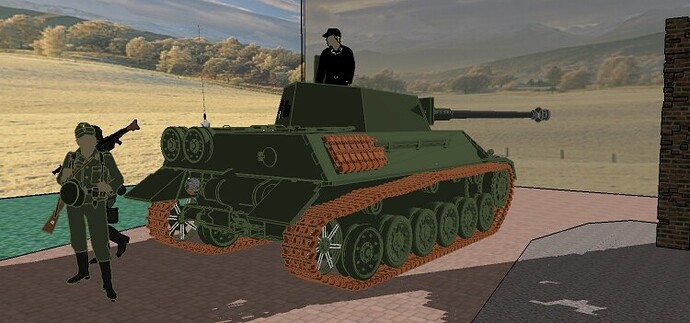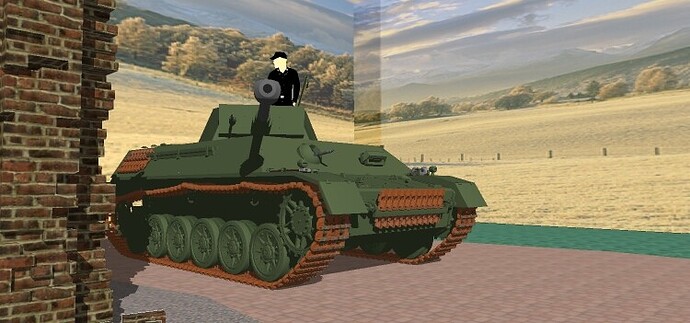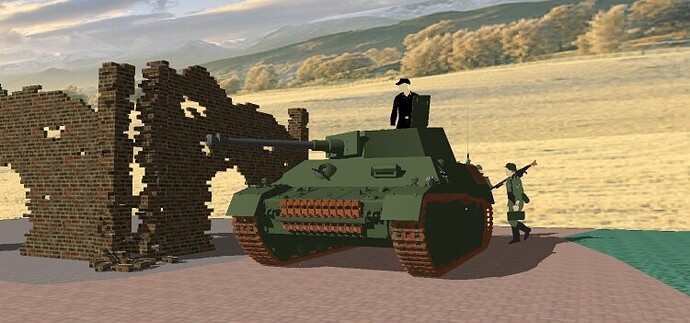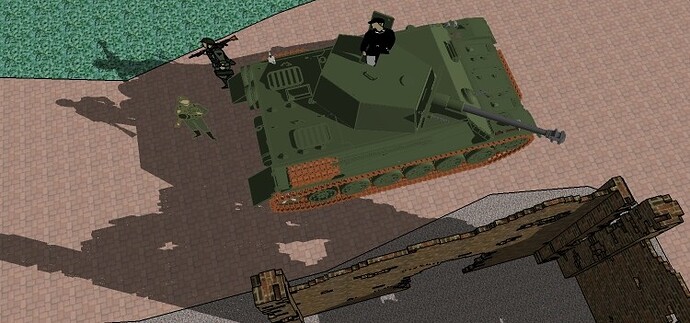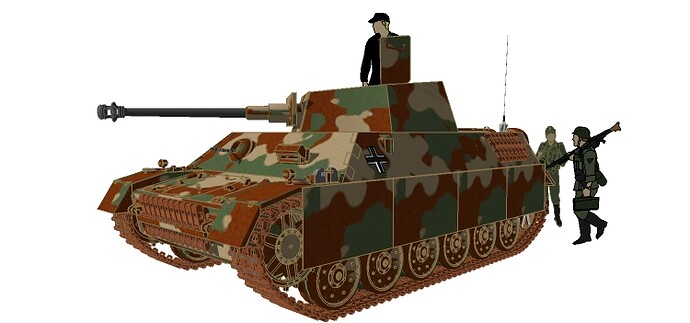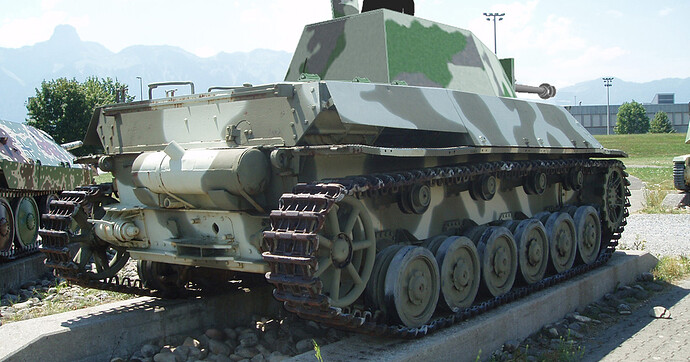Because of the discussion about the Panther tank I thought it would be better to start another thread. I will not repeat everything, hoping the thread can get filled.
III/IV


Panther

I have always been intrigued by whether they could have done a sloped armour version on the Panzer IV, although the chassis had reached its weight limit it was still a pretty good reliable tank. Sloping the armour may have helped to reduce its weight for the same thickness. How it would have affected the ergonomics though I don’t know. Probably would have been cheaper than the Panther but not as good a gun.
Similar thoughts really to a sloped armour version of the Cromwell or Comet.
Whether they could have done it is not a difficult question, if you can make Tiger II’s or even a Maus :lol: you can make a sloped IV.
The problem is whether you take the risk of pulling resources into development.
In case of a IV, you would need two things: suspension issues and the power train.
-
Suspension would lead I guess to a beefed up torsion bar system like the III. Interleaved solution would help, but it would make the total again less workable on the field. “Interleaving” has disappeared after WWII … Making the step towards steel wheels as in late vehicles would be the better choice.
-
Power train … using the better III’s transmission again as in late IV’s and indeed using a bigger capacity engine.
And of course, the keen management to make a bridge from early IV production to new IV production.
The gun would not be the problem. The 75/L48 gun was more than good enough.
Few Allied tanks could survive 1 on 1 on this baby. The only reason for making + 100mm guns in WWII was the lack of tactical power.
One of the best features of the IV was its size and weight, which was in fact quite small (a feature all the behemoths did not have).
Tactically a ‘modernised’ Panzer IV would have been better than the large Cats, most of the fighting in the West was close range ambush smaller more mobile and reliable vehicles would have been better. The Stugs and Hetzer were good in ambush but the lack of a traversable turret hampered their usefulness.
Not convinced the Jagdpanzer IV was worthwhile at all, just diverted production to a vehicle that had mobility problems and an overloaded front running gear.
Stug III and Panzer IV with Hetzers and Marders for back up along with the Beute’s and converted old hulls as SPG’s.
Mind you no matter what people say about German tank design being badly conceived and implemented with too many designs, they never built a monstrosity such as the Covenanter or suffered the delays and lack of direction Britain did with tank design and armament.
:shock::shock::shock:
just looked for covenanter tank … +1700 built almost without any leaving the Isle … :lol:
The German conversions of obsolete tanks to mobile anti-tank guns were brilliant in their straightforward usefulness. No argument. Perhaps the StuG is the best design second to none of nazi german warfare.
The Covenanter was a terrible waste of rust. Unfit for combat and not really fit for training as they were so unreliable. Units were issued them and they then had to be sent straight back to the manufacturer for modifications, get them back and away they would have to go again for more mods to try and get them to work.
Fast tank but a waste, contracts were made though so they had to build them, same with the Liberty engine originally for the Centaur, useless as a tank engine but they had to build them because of a contract.
I think the Germans would have been better off enhancing the Pz IV. The Panther is an excellent tank, however, I feel time wise it would have been quicker to improve upon the design of the Pz IV. Sloping armour and other such improvements mentioned by Leccy and Steben would have allowed it to compete with other Allied tanks such as the T-34 or Sherman Firefly whilst keeping some of it’s advantages such as being smaller. I often feel German tank design lost it’s way towards the end of the war with the designers believing that a few massive super tanks would win the war when in reality larger numbers of decent medium tanks would have helped them more (something the Russians showed with T-34s).
Had the Germans stuck to the original prewar plan , and not allowed it to gather mass to meet new threats, the Panzer III replacement was the VK-20 design, which would have gone into mass production in early 1941. The original design was a 20 ton class Panzer III style design. This evolved by 1940/41 into the VK 24, which resembled a mini Panther hull [1 less set of roadwheels] and a Panzer III/IV turret, with enought turret ring to mount a Pak 40. Probably end up about 28 tons with 50mm face hardened glacis armor sloped at 55°. This tank would resemble Stebens design and gone into mass production in early 1942.
In theory it should have replaced the Panzer III , one for one on the production line.
VK2001

definitely going towards Panther.
On the other hand, no sloped armour nor assurance the interleaved suspension system would be more reliable.
I still would have favoured the III/IV system with six steel roadwheels on torsion bars, III transmission and at least 350-400hp engine with a total weight lower than 30 metric tons.
Speed at least better than Panther, let’s say 45-50 km/h
In other words: keeping everything under specs of the T34. Lighter, smaller, but with a motherload of a gun.

Some math
Changing frontal armour of 80mm to 60mm @ 48 degrees (50cm / 45cm) gives equivalent of 90mm frontal @ 0 degrees but with increased ricochet effect
at the same weight (if reduction of original flat glacis of 15mm is taken in account)
Addition of frontal plate at the sides (if side armour is changed to sloped) gives +/- 300 kilograms extra.
Changing side armour from 35mm to 30mm @ 40 degrees (40 / 45cm) gives equivalent of 40mm with slight increased ricochet effect with same weight. If you take sloped front into account this lengthens the side plates with two triangles of about 0.5m x 0.45m = 0.225 sq m. This about 105 kilograms.
Total 405 kilograms extra.
Yet I would add straight internal side plates as there were straight plates in the original, @ 15mm and vertical plates of 10mm to close the space onder the side armour. This would give 2* 3.5 meters * 7800 kg * (0.450.01 + 0.40.015). = 570 kilograms extra. Tis “double armour” would protect against hollow charge and eliminate the need for “schürtzen” at the sides or at least above the wheels. Side skirts weigh around 250 kg - 300 kg.
Total extra weight around 0.75 - 1 ton ( 3 a 4 %).
Given that the engine would need to beefed up to around 350 - 400 hp (raise of 16 to 30%), it wouldn’t be a problem and the engine choice would be almost directly influenced by top speed demands.
Man, I like this tank … :mrgreen:
What year is this supposed to go into production?
both simplified turret and the envisioned III/IV base were independent projects around early 1944, that were ought to be ready for further developement in 1944.
The "idea "of hybrid III/IV chassis was however much older.
In three tone camo
PazJager IV photoshopped (trimmed and addition of simplified turret)
(Thun, Switzerland)
Steben how much older? can you draw on any sources?
-
VK2001 - BW 40
started in 39 - cancelled in 1940
had no sloped armour -
Design of IV woth sloped armour was ordered in december 1942, cancelled in early 1943.
-
Nashorn / hornisse tank destroyer was based on IV with III power train. prohject started in early 1942 as “Geschützwagen III/IV” and entered production in early 1943 (somewhat same time as pz IV H)
I searched sites as “Achtung Panzer” and literature as the Osprey series.
It is my view that a III/IV was possible at the front in 1943 (perhaps Kursk), definitely if they would have seen “Panther” as a small run “heavy” tank side project.
It would have had a standard IV turret at the start, with a simplified one in 1944.
In fact, Jagdpanzer IV superstructure is a III/IV one but stretched a little higher (as can be seen in my photoshop of the Thun example)
It (actually the late version wtith 75L70 gun) was nose heavy because of the gun overhang, unchanged suspension and the 80mm armour.
Again, even the L48 Hunter with 60mm @ 50° was effective, the longer gun only an offspring of the exagerated gun race.
I can see such a tank in mass production in mid 1943 along side Panther production especially if Tiger programme resources are rolled into an expanded Panther production.
BTW there was a reason sloped armor was not included in early tank designs. Spanish Civil war showed that when the FH sloped armor of the Panzer I was struck by over matching shells…[t/d less than 1] the FH shattered and offered less resistance. FH vertical armor offered more resistance until APCBC ammo became the norm , mid war.
I don’t think the PzIV ( even modernized vertion like on pictures above) could even be compared with Panther. The speed wasn’t actualy a matter. Germany lead the defence war since 1943. They needs exactly the such tank like Panther - with big frontal armour ,the wide tracks and powerful gun. I agree the Tigers was too expensive and , finally strategically useless. But Panther was a new-generation tank, masterpiece among medium class tanks of that period.It wasn’t mass produced , at least in scale like the Sherman was, but i do beleive if Hitler refuged the Tigers project to a favour of Panther- germany could face advanced allies panzer armies with 10-15 thousands of Panthers.Enough to take war’s initiative back.

